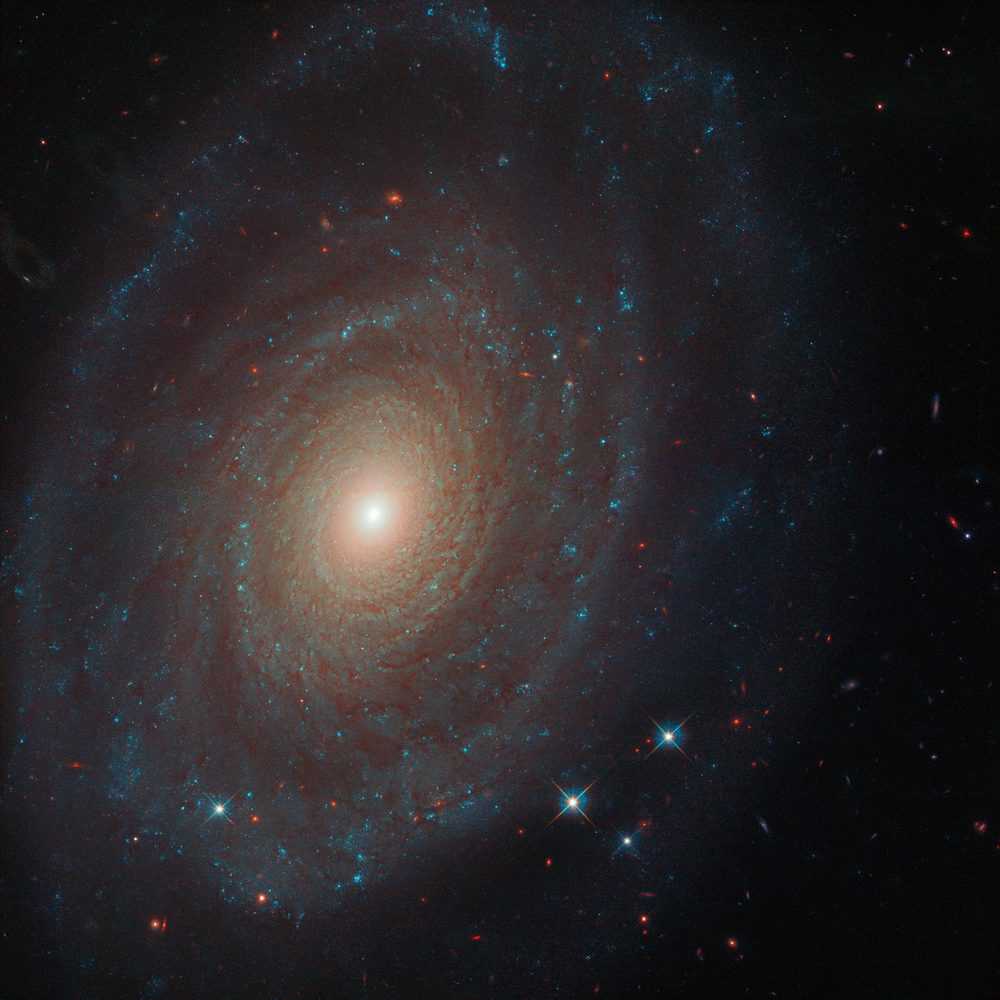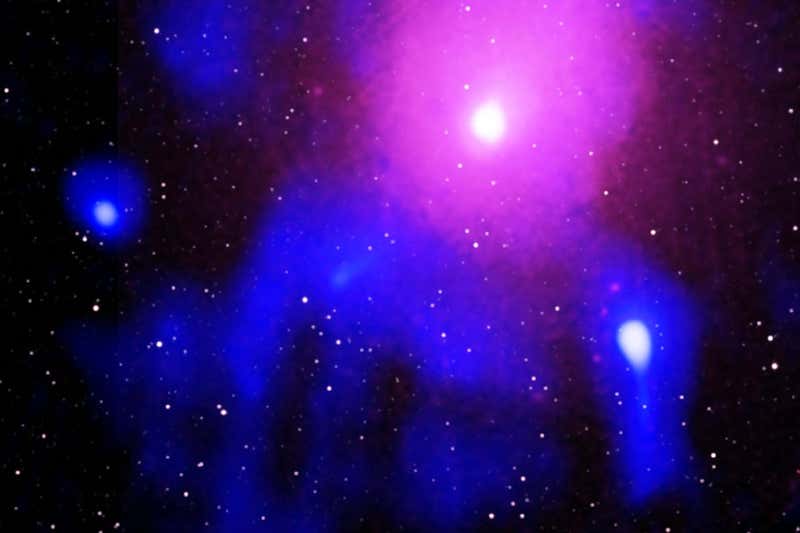Blog
Urinetown the Musical by Theater 55 at the Illusion Theater. 2pm matinee and 730pm evening show. Music by Music by Music by Neal McIntosh, Jamie Carter, Chad Green, Paul Fontara and mick laBriola.

more...
Galaxy NGC 691, an archetypal spiral galaxy, was captured by the Hubble Space Telescope. Credit: ESA/Hubble & NASA, A. Riess et al. This image of an archetypal spiral galaxy was captured by the NASA/ESA Hubble Space Telescope. The subject of this image is known as NGC 691, and it can be found some 120 million light-years from Earth. This galaxy was one of thousands of objects discovered by astronomer William Herschel during his prolific decades-long career spent hunting for, characterizing, and cataloging a wide array of the galaxies and nebulae visible throughout the night sky — almost 200 years before Hubble was even launched.
The intricate detail visible in this Picture of the Week would likely be extraordinary to Herschel. Hubble was able to capture an impressive level of structure within NGC 691’s layers of stars and spiraling arms — all courtesy of the telescope’s high-resolution Wide Field Camera 3.

Khaled Hadj Ibrahim (Arabic: خالد حاج إبراهيم, born 28 February 1960), better known by his mononym Khaled (Arabic: خالد; Arabic pronunciation: [ˈxaːled]), is an Algerian musician, singer and songwriter born in Oran, Algeria. He began recording in his early teens under the name Cheb Khaled (الشاب خالد, Arabic for “Young” Khaled, as opposed to the traditionalist Sheikh elders). He was crowned “King of Raï” in the first rai festival in Oran and has since become the world’s best-known Arab singer. His most famous songs are “Didi“, “Aïcha” and “C’est la vie” as well as “Alech Taadi”, which was prominently featured in the film The Fifth Element. Khaled Hadj Brahim was born in 1960 in Oran‘s Eckmühl neighborhood, Algeria. On 12 January 1995, Khaled married Samira Diabi, 27, with whom he has four daughters and one son.
more...Richie Cole (born February 29, 1948) is an American jazz saxophonist, composer, and arranger. Cole was born in Trenton, New Jersey. He started playing alto saxophone when he was ten years old, encouraged by his father, who owned a jazz club in New Jersey. He is a graduate of Ewing High School, in Ewing Township, New Jersey. Cole won a scholarship from Down Beat magazine to the Berklee School of Music in Boston.
In 1969 he joined drummer Buddy Rich‘s Big Band. After working with Lionel Hampton‘s Big Band and Doc Severinsen‘s Big Band, he formed his own quintet and toured worldwide, doing a great deal to popularize bebop and his own “alto madness” style in the 1970s and early ’80s. He formed the Alto Madness Orchestra in the 1990s.
Cole has performed and recorded with Eddie Jefferson, Nancy Wilson, Tom Waits, The Manhattan Transfer, Hank Crawford, Freddie Hubbard, Eric Kloss, Bobby Enriquez, Phil Woods, Sonny Stitt, Art Pepper, and Boots Randolph. He has recorded over fifty albums, including his top hit album Hollywood Madness (Muse, 1979) and his tribute album to Leonard Bernstein, Richie Cole Plays West Side Story (Music Masters, 1997).
more...James Francis Dorsey (February 29, 1904 – June 12, 1957), professionally known as Jimmy Dorsey, was an American jazz clarinetist, saxophonist, composer and big band leader. He recorded and composed the jazz and pop standards “I’m Glad There Is You (In This World of Ordinary People)” and “It’s The Dreamer In Me“. His other major recordings were “Tailspin“, “John Silver“, “So Many Times“, “Amapola“, “Brazil (Aquarela do Brasil)”, “Pennies from Heaven” with Bing Crosby, Louis Armstrong, and Frances Langford, “Grand Central Getaway”, and “So Rare“. He played clarinet on the seminal jazz standards “Singin’ the Blues” in 1927 and the original 1930 recording of “Georgia on My Mind“, which were inducted into the Grammy Hall of Fame.
Jimmy Dorsey was born in Shenandoah, Pennsylvania, United States, the first son of Theresa Langton Dorsey and Thomas Francis Dorsey. His father, Thomas, was initially a coal miner, but would later become a music teacher and marching-band director. Both Jimmy and his younger brother,Tommy Dorsey, were musically active during their childhoods and by the age of seven, Jimmy was already playing with his father’s band. He made his first public appearance at the age of 9 while playing trumpet with J. Carson McGee’s King Trumpeters in New York in 1913. He switched to alto saxophone in 1915, and then learned clarinet. Jimmy Dorsey played on a clarinet outfitted with the Albert system of fingering, as opposed to the more common Boehm system used by most of his contemporaries including Benny Goodman and Artie Shaw.
more...Urintown by Theater 55 (https://theatre55.org) opening night at the Illusion Theater (http://www.illusiontheater.org) running from Friday February 28th thru Sunday March 15th. Music by Music by Neal McIntosh, Jamie Carter, Chad Green, Paul Fontara and mick laBriola. The plot of Urinetown is fairly straightforward. The scene is a city in a parallel universe in the mid 1900’s in which the majority of the citizens’ dreary low-class existence is compounded by a water shortage, which has lead to the institution of pay-per-use public bathrooms and the jailing of unsanitary offenders.

more...
Substitute teaching this week at Friends School, teaching Percussion & Guitar classes. Mounting material for upcoming performance. (For a complete listing of Daily Music go to Blog pages at micklabriola.com)
more...Astronomers have discovered the biggest explosion we have ever seen. They spotted the remnants of this blast in a distant galaxy, using some of the most powerful telescopes we have, including NASA’s Chandra X-ray Observatory and the Murchison Widefield Array in Australia. The observations revealed a strange void at the centre of a huge galaxy about 390 million light years away in the Ophiuchus galaxy cluster. The space inside that void is seething with radio waves, which come from electrons accelerated almost to the speed of light. The researchers concluded that those electrons were accelerated by a huge explosion from just near a black hole, which smashed away all the gas in the area to leave behind just a void filled with electrons and radiation. The explosion released five times more energy than the previous record holder. “You could fit fifteen Milky Way galaxies in a row into the crater this eruption punched into the cluster’s hot gas,” Simona Giacintucci at the US Naval Research Laboratory, who was part of the team that found the explosion, said in a press release.
This sort of explosion occurs when lots of matter is falling into a supermassive black hole. As the black hole spins and distorts space-time, that matter is diverted into a powerful jet speeding away from it. The jet that punched a hole in this galaxy seems to be gone now. “We’ve seen outbursts in the centres of galaxies before, but this one is really, really massive,” said Melanie Johnston-Hollitt at Curtin University in Australia, also part of the team, in a press release. “We don’t know why it’s so big.” The void is about 750,000 light years wide. The energy required to create a void that large is about 10 billion times the lifetime energy output of the sun. It isn’t clear how the black hole could have produced it, especially given that it isn’t active any more.

Lewis Brian Hopkins Jones (28 February 1942 – 3 July 1969) was an English musician, best known as the founder and original leader of the Rolling Stones. Initially a slide guitarist, Jones would go on to play a wide variety of instruments on Rolling Stones recordings and in concerts, such as rhythm and lead guitar, sitar, dulcimer, various keyboard instruments such as piano and mellotron, marimba, wind instruments such as harmonica, recorder, saxophone, as well as drums, vocals and numerous others.
Jones and fellow guitarist Keith Richards developed a unique style of guitar play that Richards refers to as the “ancient art of weaving” where both players would play rhythm and lead parts together; Richards would carry the style on with later Stones guitarists and the sound would become a Rolling Stones trademark.
After he founded the Rolling Stones as a British blues outfit in 1962, and gave the band its name, Jones’ fellow band members Richards and Mick Jagger began to take over the band’s musical direction, especially after they became a successful songwriting team. Jones also did not get along with the band’s manager, Andrew Loog Oldham, who pushed the band into a musical direction at odds with Jones’ blues background. At the same time, Jones developed alcohol and drug problems, and his performance in the studio became increasingly unreliable, leading to a diminished role within the band he had founded. In June 1969, the Rolling Stones asked Jones to leave; guitarist Mick Taylor took his place in the group. Jones died less than a month later, drowning in the swimming pool at his home at the age of 27.
Long-time Rolling Stones bass guitarist Bill Wyman said of Jones, “He formed the band. He chose the members. He named the band. He chose the music we played. He got us gigs. … he was very influential, very important, and then slowly lost it – highly intelligent – and just kind of wasted it and blew it all away.”
https://www.youtube.com/watch?v=pr91kyjkdLM
more...John Aloysius Fahey (/ˈfeɪhi/ FAY-hee; February 28, 1939 – February 22, 2001) was an American fingerstyle guitarist and composer who played the steel-string acoustic guitar as a solo instrument. His style has been enormously influential and has been described as the foundation of American Primitive Guitar, a term borrowed from painting and referring mainly to the self-taught nature of the music and its minimalist style. Fahey borrowed from the folk and blues traditions in American roots music, having compiled many forgotten early recordings in these genres. He would later incorporate 20th-century classical, Portuguese, Brazilian, and Indian influences into his work.
Fahey spent many of his later years in poverty and poor health, but enjoyed a minor career resurgence in the late 1990s, with a turn towards the avant-garde. He also created a series of abstract paintings in his final years. Fahey died in 2001 from complications from heart surgery. In 2003, he was ranked 35th on Rolling Stone magazine’s “100 Greatest Guitarists of All Time” list.
Fahey was born into a musical household in Washington, D.C. in 1939. Both his father, Aloysius John Fahey, and his mother, Jane (née Cooper), played the piano. In 1945, the family moved to the Washington suburb of Takoma Park, Maryland, where his father lived until his death in 1994. On weekends, the family attended performances of the top country and bluegrass acts of the day, but it was hearing Bill Monroe‘s version of Jimmie Rodgers‘ “Blue Yodel No. 7” on the radio that ignited the young Fahey’s passion for music.
more...Charles Gayle (born February 28, 1939) is an American free jazz musician. Initially known as a saxophonist who came to prominence in the 1990s after decades of obscurity, Gayle also performs as pianist, bass clarinetist, bassist, and percussionist.
Charles Gayle was born in Buffalo, New York. Some of his history has been unclear due to his reluctance to talk about his life in interviews. He briefly taught music at the University at Buffalo before relocating to New York City during the early 1970s.
more...Willie Bobo was the stage name of William Correa (February 28, 1934 – September 15, 1983), a Latin and jazz percussionist of Puerto Rican ancestry.
William Correa grew up in Spanish Harlem, New York City. He made his name in Latin Jazz, specifically Afro-Cuban jazz, in the 1960s and 1970s, with the timbales becoming his favoured instrument. He met Mongo Santamaría shortly after his arrival in New York and studied with him while acting as his translator, and later at the age of 19 joined Tito Puente for four years.
The nickname Bobo is said to have been bestowed by the jazz pianist Mary Lou Williams in the early 1950s.
more...In flamenco a tango (Spanish pronunciation: [ˈtaŋɡo]) is one of the flamenco palos closely related in form and feeling to the rumba flamenca. It is often performed as a finale to a flamenco tiento. Its compás and llamada are the same as that of the farruca and share the farruca’s lively nature. However, the tango is normally performed in the A Phrygian mode. In some English sources the flamenco tango is written with an -s; “the tangos is…”
The flamenco tango is distinct from the flamenco rumba primarily through the guitar playing. In Rumba the guitar flows more freely, whereas in Tangos the accents on beats 2, 3 & 4 are marked clearly with heavy strumming.
Tangos is only vaguely related to Argentine tango, and objectively they only share compás binario or double stroke rhythm. The fact that Argentine tango is one of the first couple dances in America has led historians to believe that both could be based in a minuet-style European dance, therefore sharing a common ancestor, while those who compare the present day forms do not see them as related.
more...February 26, 2020
Substitute teaching this week at Friends School, teaching Percussion & Guitar classes. Mounting material for upcoming performance.
(For a complete listing of Daily Music go to Blog pages at micklabriola.com)
The optical image from the CFHT telescope with the distribution of neutral hydrogen in the form of a large ring shown in red as observed by the GMRT. The other two red blobs show the distribution of neutral hydrogen around two other galaxies which are in the vicinity of the ring. Credit: O. Bait (NCRA-TIFR/GMRT), Duc (ObAS/CFHT)
A team of astronomers at the National Centre for Radio Astrophysics (NCRA) in Pune, India have discovered a mysterious ring of hydrogen gas around a distant galaxy, using the Giant Metrewave Radio Telescope (GMRT). The ring is much bigger than the galaxy it surrounds and has a diameter of about 380,000 light-years (about 4 times that of our Milky Way).
The galaxy (named AGC 203001), is located about 260 million light-years away from us. There is only one other such known system with such a large neutral hydrogen ring. The origin and formation of such rings is still a matter of debate among astrophysicists.
Neutral hydrogen emits radio waves at a wavelength of about 21cm. This radiation from neutral hydrogen atoms has allowed radio astronomers to map the amount and distribution of neutral hydrogen gas in our Milky Way galaxy and in other galaxies in the Universe. Typically, large reservoirs of neutral hydrogen gas are found in galaxies which are actively forming new stars. However, despite showing no signs of active star formation the galaxy AGC 203001 was known to have large amounts of hydrogen, although its exact distribution was not known. The unusual nature of this galaxy motivated astronomers in NCRA to use the GMRT to conduct high-resolution radio observation of this galaxy to find out where in the galaxy this gas lies.

Chuck Wayne (February 27, 1923 – July 29, 1997) was a jazz guitarist. He came to prominence in the 1940s, and was among the earliest jazz guitarists to play in the bebop style. Wayne was a member of Woody Herman‘s First Herd, the first guitarist in the George Shearing quintet, and Tony Bennett‘s music director and accompanist. He developed a systematic method for playing jazz guitar.
Wayne was known for a bebop style influenced by saxophone players of his time, especially Charlie Parker and Coleman Hawkins. In an era when many guitarists used four-square, mandolin-style picking, with rigid up-down stroke articulation, Wayne developed a technique not widely adopted by others until decades later. He also developed a comprehensive approach to guitar chords and arpeggios – based on generic tetrad forms spanning all possible inversions, in varying degrees of open voicing. This highly analytic approach to the fretboard was later documented in a series of theory books, some released posthumously.
Chuck Wayne was born Charles Jagelka in New York City to a Czechoslovakian family. As a boy he learned banjo, mandolin, and balalaika. In the early 1940s he began playing in jazz bands on 52nd Street. After two years in the Army, he returned to New York City, joined Joe Marsala‘s band, and settled in Staten Island (until a 1991 move to New Jersey). He changed his musical style after hearing Charlie Parker, recording with Dizzy Gillespie in 1945.
more...More Posts
- Archie Shepp
- SUPPORT UKRAINE THE UKRAINIAN FOLK
- Daily Roots Al Campbell
- Cosmos Lunar Eclipse 2022
- Nat Adderley Jr.
- Famoudou Don Moye
- Fred Guy
- STOP THE WAR DakhaBrakha
- Daily Roots The Ovations
- Cosmos Sh2-64
- Ian Underwood
- Sun Ra
- Richard Wagner
- STOP PUTIN Vesnyanka
- Daily Roots Johnny Clarke
- Cosmos Abell 7
- Bill Holman
- Larance Marable
- Fats Waller
- FREE UKRAINE Burdon